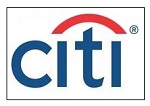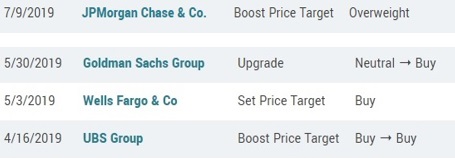By Pam Martens and Russ Martens: August 16, 2019 ~
 The Dow Jones Industrial Average rallied 99.97 points yesterday but the mega Wall Street bank, Citigroup, closed in the red, down 0.15 percent. That decline follows a dramatic loss of 5.28 percent on Wednesday, a day that the Dow was down only 3.05 percent.
The Dow Jones Industrial Average rallied 99.97 points yesterday but the mega Wall Street bank, Citigroup, closed in the red, down 0.15 percent. That decline follows a dramatic loss of 5.28 percent on Wednesday, a day that the Dow was down only 3.05 percent.
Citigroup’s closing price yesterday was $61.32. The stock has lost more than 88 percent of its value since 2007, despite its attempt to dress up the share price with a 1-for-10 reverse stock split in 2011, which left its long-term shareholders with 1 share for each 10 shares previously held.
Citi’s share price has also been dropping like a rock since July 24 of this year when it closed at $73.01. But that hasn’t triggered a rethink on the part of its competitor banks on Wall Street who have “Buy” or “Overweight” ratings on Citi’s stock according to MarketBeat.
From September 20, 2018 to the close of trading on Christmas Eve of last year, Citigroup lost a whopping 34 percent of its value. That’s in just a little over three months. Nothing about its situation or the global macroeconomic picture has changed for the better after last year’s rout but, for some reason, four of its big bank peers got very bullish on its stock this year.
As you will see from the MarketBeat data below, on April 16 of this year, UBS reiterated its Buy on Citi and boosted its price target from $78 to $83. Less than three weeks later, Wells Fargo put a very bullish price target of $90 a share on Citi. Less than a month after that, on May 30, Goldman Sachs upgraded its rating on Citi to Buy from Neutral with Goldman analyst Richard Ramsden raising his price target from $71 to $77 a share. Then on July 9, according to MarketBeat, JPMorgan Chase entered the fray by lifting its price target on Citi from $75 to $77.
Three of the four banks mentioned above, UBS, Goldman Sachs and JPMorgan Chase, own Dark Pools that actively trade Citigroup’s stock every single week – in the dark. The public doesn’t get a look at what was traded in these Dark Pools until three weeks after the fact. And when that Dark Pool data is finally reported by Wall Street’s self-regulator, FINRA, it doesn’t show what day of the week the trades occurred or what time of day. The essential data that would allow a forensic investigator to see if there is funny business going on is missing. The trading data is simply aggregated for the whole week for each Dark Pool.
But we can tell you this, for the week of April 15 in which UBS made its bullish call on Citigroup, the UBS Dark Pool, UBSA, traded 2.3 million shares of Citigroup in a total of 18,450 separate trades. That’s a monster amount of stock for one Dark Pool to trade in one individual stock in a week.
For the week of June 3, the week after Goldman Sachs made its bullish call on Citigroup, Goldman’s Dark Pool called Sigma-X2 traded 453,368 shares of Citigroup in 2,753 separate trades. That may not, however, be the total of trading that Goldman did in Citigroup shares because, as we reported in June, the Securities and Exchange Commission is allowing Goldman to trade in its Dark Pools on four continents.
For the week of July 8, in which JPMorgan Chase put out its bullish rating on Citi, JPMorgan’s two Dark Pools (yes, the SEC allows it to own two separate Dark Pools) traded a combined total of more than 600,000 shares of Citi’s stock. The Dark Pool JPM-X traded 380,132 shares in 1,759 separate trades while JPB-X traded 242,224 shares in 1,302 separate trades.
Why would Citigroup’s competitor banks want to see its share price do well? For one thing, Citigroup played a major role in collapsing the entirety of Wall Street in 2008. Nobody on Wall Street knew with any certainty who was a counterparty to Citi’s derivative trades as the bank was teetering in 2008 and so lending between the mega Wall Street banks simply dried up, causing a downward repricing of all of the Wall Street bank stocks. Citi’s Wall Street competitors don’t want to see a replay of that again.
Unfortunately, neither the SEC nor Congress have meaningfully reformed the derivatives market. As of the end of the first quarter of this year, the Office of the Comptroller of the Currency reports that Citigroup’s bank holding company held $51 trillion in notional (face amount) of derivatives. That’s $10 trillion more in derivatives than it held on March 31, 2008, the year it blew itself up, according to the data at the Office of the Comptroller of the Currency, the regulator of national banks.
Citigroup ended up receiving the largest government bailout in U.S. banking history. In addition to a government guarantee on over $300 billion of its “assets” and a $45 billion taxpayer equity capital infusion, the Federal Deposit Insurance Corporation also guaranteed $5.75 billion of Citigroup’s senior unsecured debt and $26 billion of its commercial paper and interbank deposits. And while all of these serial bailouts of Citigroup were happening in plain sight by Federal government agencies like the U.S. Treasury and FDIC, the U.S. central bank, the Federal Reserve, was secretly funneling a cumulative $2.5 trillion in revolving loans to Citigroup. A significant part of those Fed loans had interest rates below 1 percent while Citigroup was allowed to charge struggling consumers caught in a Wall Street-induced economic collapse high double-digit interest rates on their credit cards.
If there is funny business going on with these Buy ratings on Wall Street, it would not be the first time. On April 28, 2003, the Securities and Exchange Commission settled rigged research practices with 10 Wall Street banks for $875 million. Some of the bank analysts had been putting out Buy recommendations on certain stocks while calling the companies “crap” and “dogs” in internal emails. But no one went to jail. Just two individual analysts were charged by the SEC: Jack Grubman of Citigroup’s former Salomon Smith Barney unit and Merrill Lynch’s Henry Blodget. Both men were barred from future affiliation with a broker-dealer and paid fines that were a fraction of the bonuses they had collected.
The tragic news for U.S. markets and U.S. investors is that until Americans reform the campaign finance system in the U.S., that currently permits Wall Street to effectively own the President’s transition team that selects the Federal regulators of Wall Street, nothing meaningful is going to change and the nation will remain a heartbeat away from the next epic financial crisis on Wall Street.


